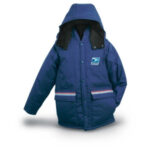The United States Marine Corps is set to equip its personnel with the next generation of Marine Combat Uniforms, significantly enhancing protection against burn injuries and improving uniform durability. The Enhanced Fire Resistant Combat Ensemble (EFRCE) represents a crucial upgrade to the existing Flame Resistant Combat Ensemble (FRCE) inventory, incorporating advanced materials for superior performance and longevity in demanding operational environments. This initiative underscores the Marine Corps’ commitment to equipping Marines with the best possible gear for their safety and mission effectiveness.
The EFRCE system features a redesigned long-sleeve shirt and trousers constructed from a cutting-edge flame-resistant fabric. This innovative material is engineered to self-extinguish, dramatically reducing both the incidence and severity of burn injuries in combat situations. Developed in collaboration with the U.S. Navy, the EFRCE will be standard issue for Marines and Sailors assigned to Navy Expeditionary Combat Command and Naval Special Warfare Command as they are deployed, ensuring consistent protection across joint operations.
Alt text: U.S. Marines in standard issue combat uniforms stand ready in a field environment, showcasing typical deployment gear.
According to John Bauer, a textile technologist at Marine Corps Systems Command (MCSC), extensive industry research played a pivotal role in the EFRCE’s development. “Marine Corps Systems Command conducted industry research and found that there are better and more durable materials available that did not sacrifice protection or comfort,” Bauer stated. This research-driven approach has led to significant logistical and cost efficiencies. The increased durability of the EFRCE material means that the Marine Corps can reduce the number of uniforms issued per deployment, from four to just two per Marine for the same deployment duration. This reduction not only lightens the load for individual Marines but also generates substantial cost savings for the Department of Defense.
The EFRCE is a comprehensive system within the Marine Corps’ Flame Resistant Organizational Gear (FROG) system. Beyond the core combat shirt and trousers, the FROG system includes vital protective components such as gloves, an inclement weather combat shirt designed to be worn over the EFRCE blouse in harsh conditions, and balaclavas. These elements work synergistically to provide head-to-toe flame resistance, ensuring Marines are protected in a wide range of combat scenarios and weather conditions. The EFRCE is available in four camouflage patterns to meet diverse operational needs: Woodland and Desert patterns for ground operations, and Navy Working Uniform Type II and NWU Type III for maritime environments and interoperability with Navy units.
Alt text: Detailed view of the Enhanced Fire Resistant Combat Ensemble (EFRCE) fabric, showcasing its unique texture and Woodland camouflage pattern designed for optimal concealment.
The advanced fabric of the EFRCE is a blend of nylon, cotton, and meta-aramid fibers. Meta-aramid is a high-performance synthetic material renowned for its exceptional resistance to high temperatures, chemical degradation, and abrasion. This fiber blend is critical to the uniform’s self-extinguishing capability and overall durability, ensuring that the marine combat uniforms can withstand the rigors of combat while providing consistent protection.
Design enhancements in the EFRCE combat shirt also improve functionality and comfort. The shirt is specifically tailored to fit more effectively under the Plate Carrier Generation III body armor, enhancing mobility and reducing bulk. The EFRCE combat trousers maintain a similar design to the current Marine Corps Combat Utility Uniform (MCCUU) and Navy NWU trousers, ensuring familiarity and ease of transition for Marines.
The Marine Corps’ leadership in the EFRCE development process involved a strategic partnership with the Navy Supply Systems Command (NAVSUP) to facilitate fielding the uniform system to Navy expeditionary forces. Navy Lieutenant Chris Hulse, a life cycle logistics intern for NAVSUP’s Naval Logistics Integration program, highlighted the collaborative benefits: “We have been involved with the purchase of both the FRCE and EFCRE from the beginning, especially since flame resistant capabilities are something that all branches need in certain hostile environments.” This joint acquisition approach leverages economies of scale, reducing procurement costs for both the Marine Corps and the Navy, representing a significant win for both services and for the American taxpayer. Lt. Hulse further noted that other successful joint acquisition initiatives between the two services include the Enhanced Combat Helmet and the Inclement Weather Combat Shirt, demonstrating a continued commitment to inter-service collaboration and resource optimization.
Production of the EFRCE is currently underway, with a projected inventory of 70,000 systems expected by late fiscal year 2017 to fully replace the existing FRCE supply. This large-scale rollout will ensure that Marines deployed in harm’s way will soon benefit from these significantly enhanced marine combat uniforms. The EFRCE program exemplifies the Marine Corps’ ongoing dedication to providing its Marines with the most advanced and protective equipment available, ensuring they are ready to face any challenge on the modern battlefield.
Alt text: Group of Marines participating in combat training exercises, wearing desert camouflage pattern marine combat uniforms, illustrating adaptability and readiness.

